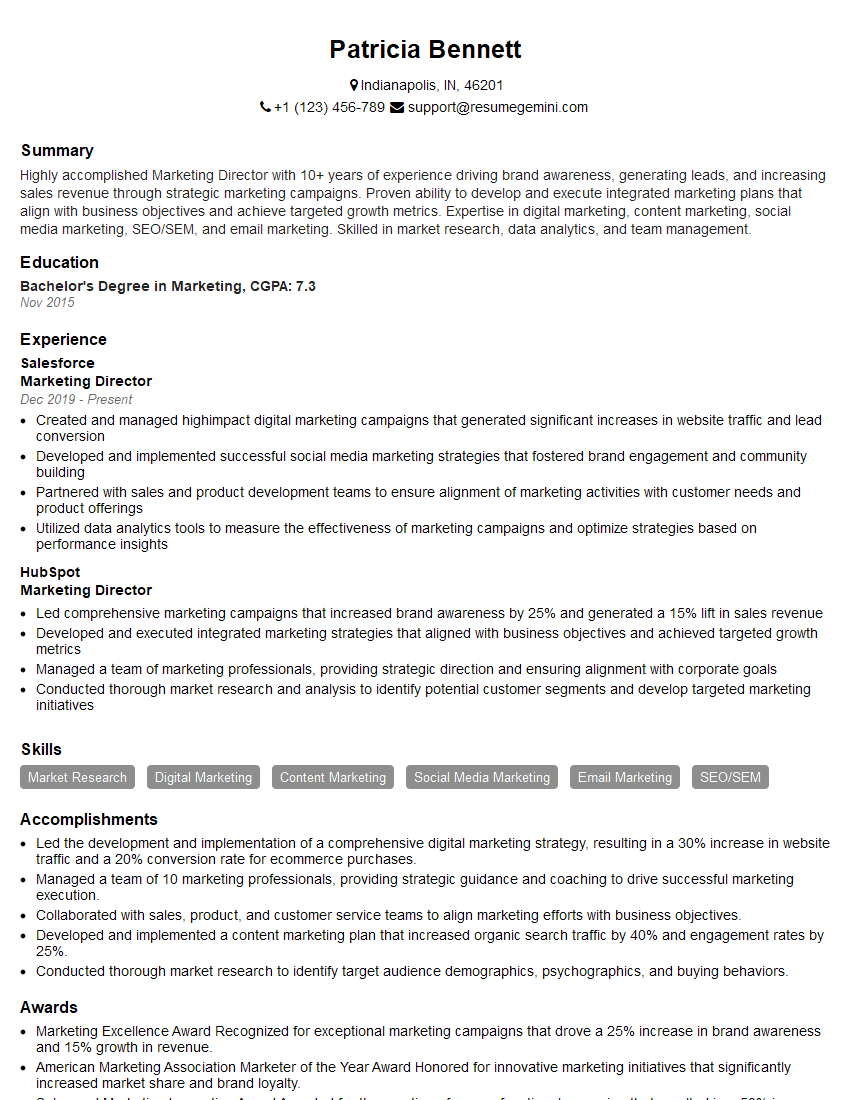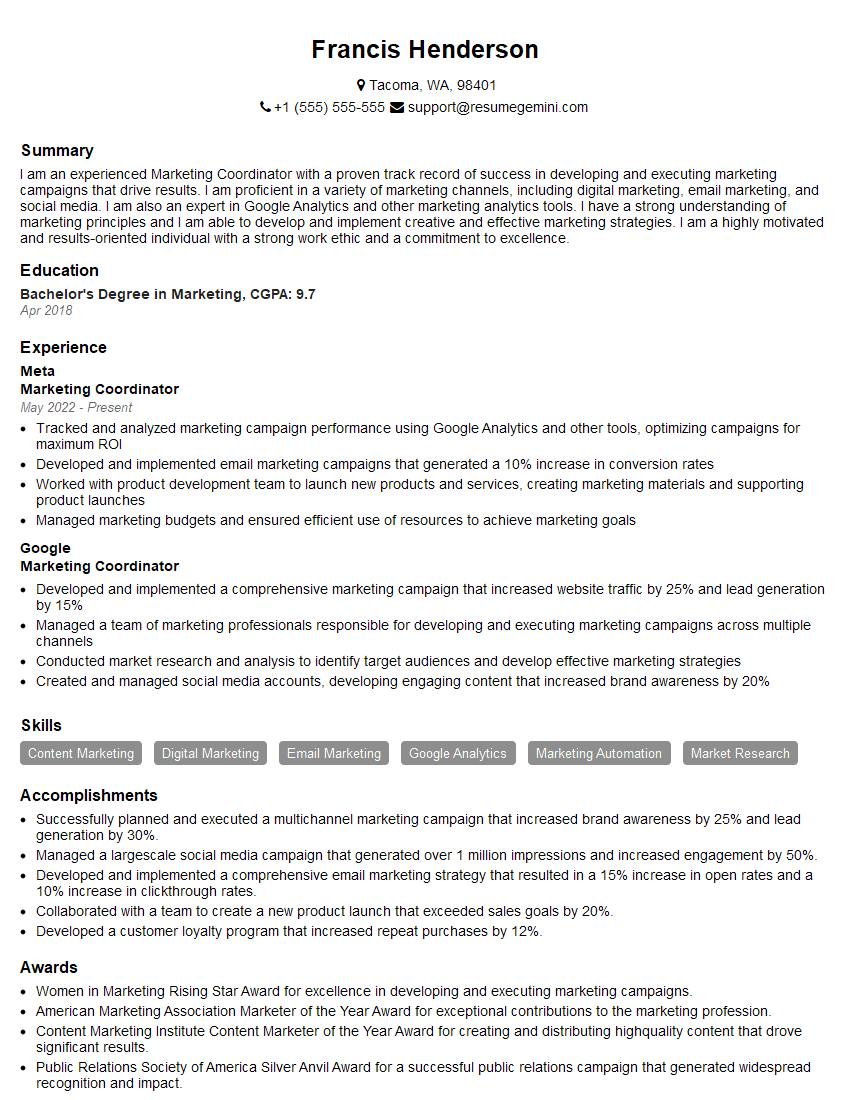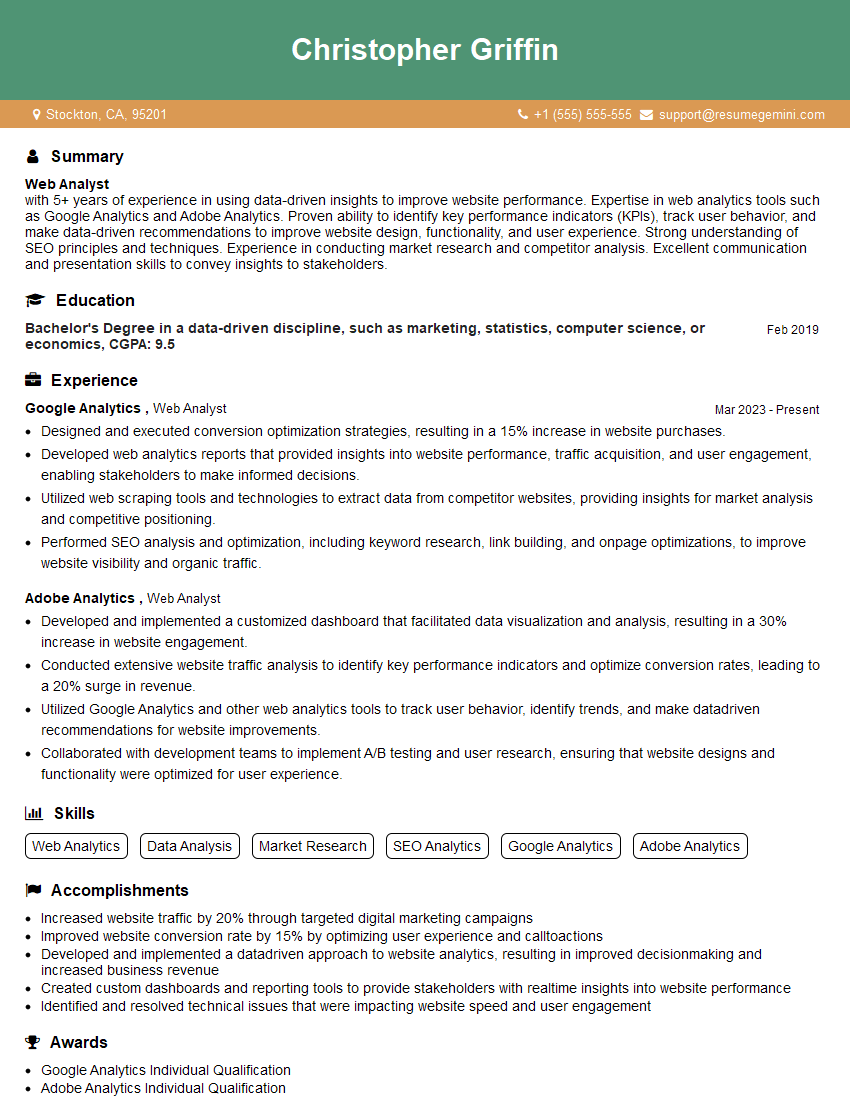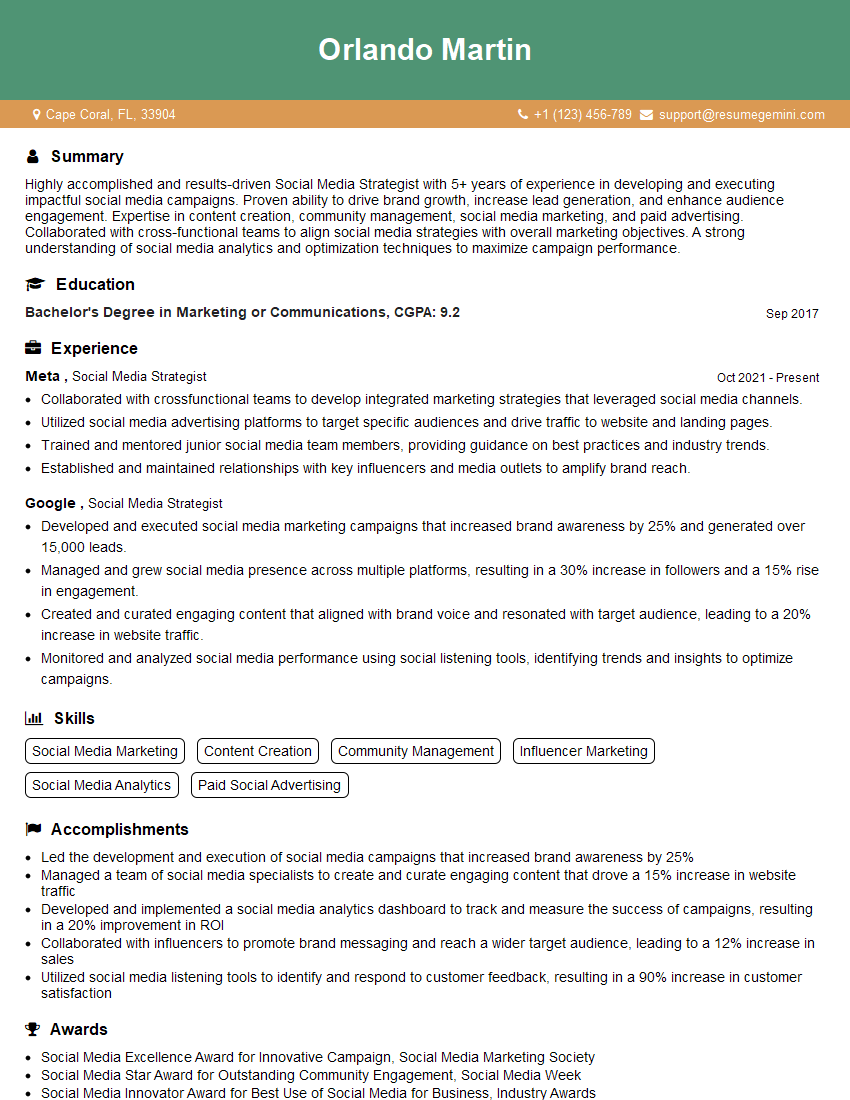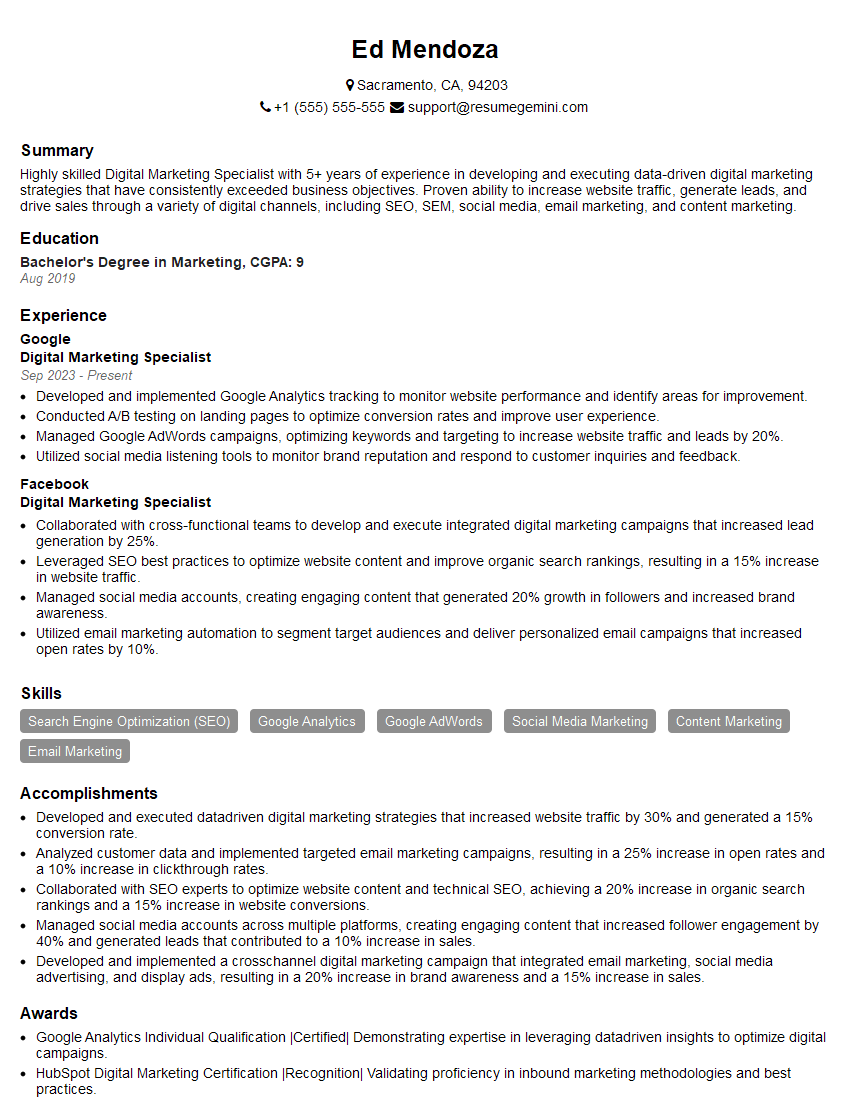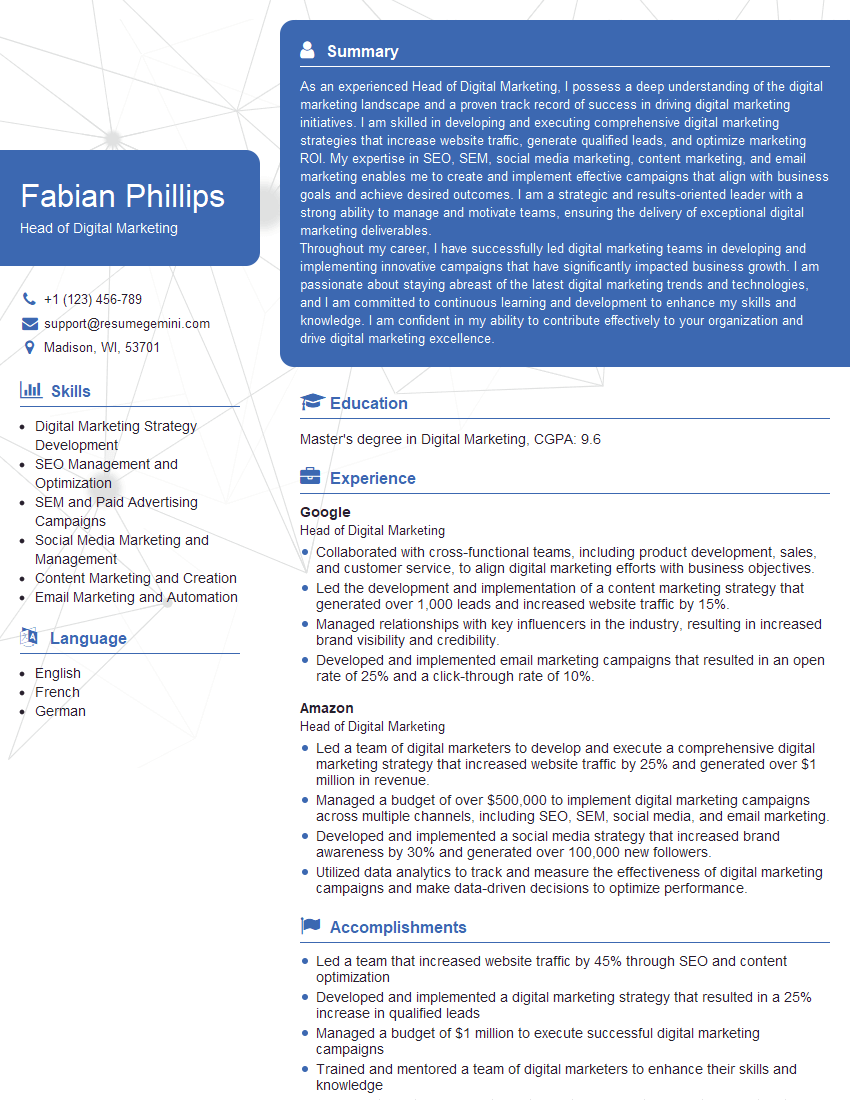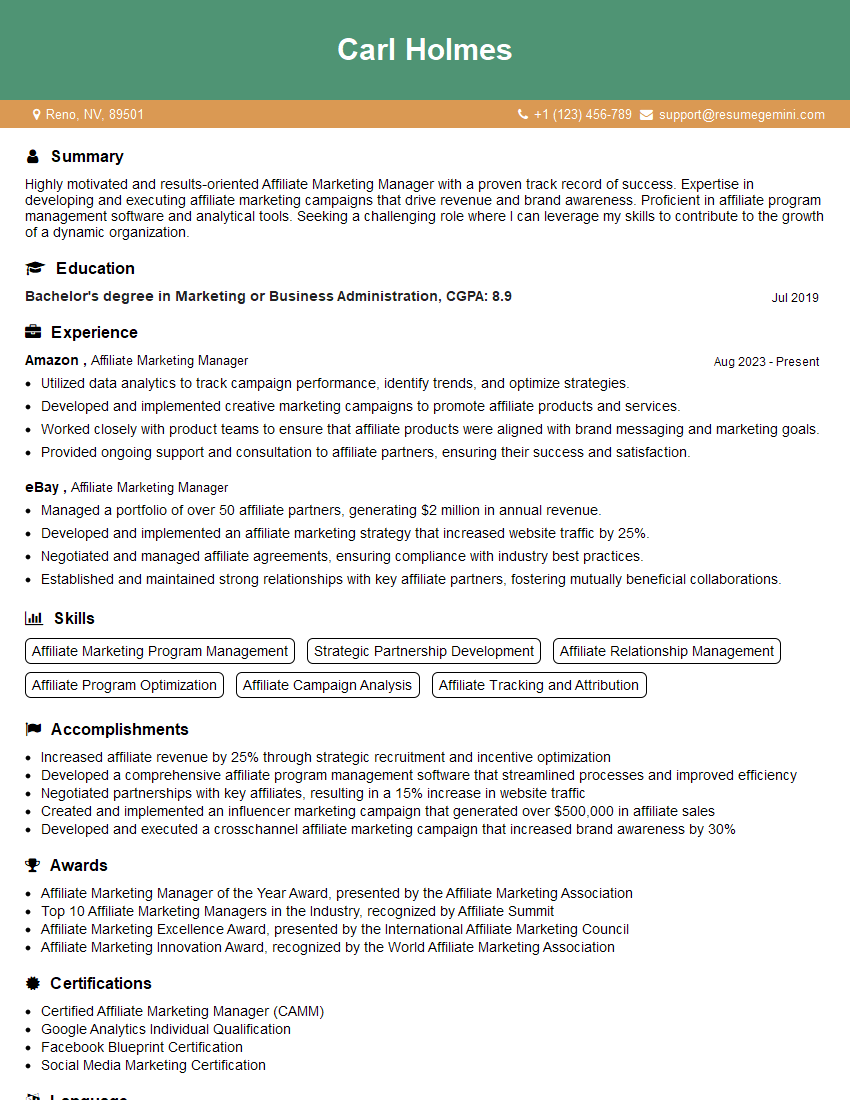Interviews are opportunities to demonstrate your expertise, and this guide is here to help you shine. Explore the essential Digital Marketing Certification interview questions that employers frequently ask, paired with strategies for crafting responses that set you apart from the competition.
Questions Asked in Digital Marketing Certification Interview
Q 1. Explain the difference between SEO and SEM.
SEO (Search Engine Optimization) and SEM (Search Engine Marketing) are both crucial for online visibility, but they differ significantly in their approach. SEO focuses on organic search results—improving your website’s ranking naturally through techniques like keyword research, on-page optimization (title tags, meta descriptions, content quality), and link building. Think of it as earning your spot on the first page of Google. SEM, on the other hand, involves paid search results through platforms like Google Ads. You essentially ‘buy’ your way onto the top of the search results pages, usually appearing prominently with a ‘Sponsored’ tag. SEO is a long-term strategy, building brand authority gradually. SEM provides immediate visibility, but requires ongoing investment.
Example: Imagine you’re selling handcrafted jewelry. SEO involves creating high-quality blog posts about jewelry care and trends, optimizing your website for relevant keywords like “handmade earrings,” and building links from reputable craft websites. SEM would involve running Google Ads campaigns targeting keywords like “unique earrings” or “artisan jewelry,” appearing in the sponsored results when users search those terms.
Q 2. What are the key performance indicators (KPIs) you track in digital marketing?
The KPIs I track in digital marketing depend on the specific campaign goals, but some consistently important metrics include:
- Website Traffic: Unique visitors, page views, bounce rate, and time on site help gauge overall website engagement.
- Conversion Rate: This measures the percentage of visitors who complete a desired action (e.g., making a purchase, signing up for a newsletter). It’s a crucial indicator of campaign effectiveness.
- Return on Investment (ROI): This calculates the profit generated for every dollar spent on marketing activities. It’s essential for justifying marketing budgets.
- Social Media Engagement: Likes, shares, comments, and follower growth indicate audience reaction and brand sentiment.
- Customer Acquisition Cost (CAC): This shows how much it costs to acquire a new customer. Lower CAC is ideal.
- Brand Awareness: Metrics like social media mentions, website traffic from brand searches, and media coverage indicate brand visibility and reach.
I use data visualization tools to monitor these KPIs regularly and adjust strategies based on performance.
Q 3. Describe your experience with Google Analytics.
I have extensive experience with Google Analytics, utilizing its various features to track website performance and user behavior. I’m proficient in setting up goals, creating custom reports, and analyzing key metrics like user acquisition, session duration, bounce rate, and conversion rates. I’ve used Google Analytics to identify areas for improvement on websites, such as navigation issues or poorly performing landing pages. For example, I recently used Google Analytics to discover that a specific landing page had a high bounce rate indicating a problem with either the design, content, or user experience. By analyzing the data further, I identified that the page’s loading speed was slow, and fixed it to improve the user experience and decrease the bounce rate.
I’m also familiar with Google Analytics’ integration with other marketing platforms, allowing for a holistic view of campaign performance. I regularly utilize its audience segmentation features to better understand user demographics and tailor marketing efforts accordingly.
Q 4. How do you measure the success of a social media campaign?
Measuring the success of a social media campaign involves analyzing several key metrics, depending on the campaign’s objectives. For example, if the goal is brand awareness, I’d track metrics like reach, impressions, and engagement rate (likes, shares, comments). If the campaign aims to drive traffic to a website, I’d monitor click-through rates (CTR) from social media posts to landing pages. For lead generation campaigns, conversion rates (e.g., form submissions, sign-ups) become crucial. Beyond these quantitative measures, I always consider qualitative feedback like comments and direct messages to understand audience sentiment and identify areas for improvement.
Example: A recent campaign for a client aimed to increase brand awareness. We tracked reach, impressions, and engagement rate on various social media platforms. While the reach was significant, the engagement rate was low. By analyzing comments and messages, we discovered the content wasn’t resonating with the target audience. We adapted our strategy, creating more engaging content tailored to audience preferences, which resulted in a substantial increase in engagement.
Q 5. What are your preferred tools for social media management?
My preferred social media management tools depend on the client’s needs and budget, but I frequently use tools such as:
- Hootsuite: For scheduling posts across multiple platforms, monitoring brand mentions, and analyzing campaign performance.
- Buffer: Another excellent option for scheduling posts and collaborating with team members on social media content.
- Sprout Social: Offers robust analytics and social listening capabilities, allowing for a deep dive into audience sentiment and engagement.
I often choose tools based on their reporting capabilities and integration with other marketing platforms for a streamlined workflow.
Q 6. Explain A/B testing and its importance in digital marketing.
A/B testing (also known as split testing) is a method of comparing two versions of a webpage or marketing asset to determine which performs better. You present two versions (A and B) to different segments of your audience and analyze which version achieves a higher conversion rate or other desired outcome. It’s crucial for optimizing marketing efforts and improving user experience.
Importance: A/B testing helps to make data-driven decisions rather than relying on assumptions. By testing different elements like headlines, images, call-to-action buttons, or website layouts, you can identify what resonates most with your audience, ultimately improving your campaign’s effectiveness.
Example: Let’s say you’re running an email campaign. Version A uses a headline emphasizing cost savings, while Version B highlights product benefits. By tracking the click-through rates of each version, you can determine which headline is more effective in driving engagement.
Q 7. Describe your experience with PPC advertising (e.g., Google Ads).
I have significant experience managing PPC (Pay-Per-Click) advertising campaigns, primarily using Google Ads. My expertise encompasses keyword research, ad copywriting, campaign structuring, bidding strategies, and performance monitoring. I’m proficient in utilizing various targeting options to reach specific demographics, interests, and behaviors. I understand the importance of using conversion tracking to accurately measure ROI and optimize campaigns for maximum efficiency.
For example, I recently managed a Google Ads campaign for a local bakery. Through detailed keyword research, I identified relevant search terms and organized them into targeted ad groups. I then crafted compelling ad copy highlighting the bakery’s unique selling points and utilized location targeting to reach potential customers within a specific radius. By continuously monitoring campaign performance and adjusting bids and keywords, I was able to achieve a significant increase in website traffic and online orders.
I am also familiar with other PPC platforms such as Bing Ads and social media advertising platforms like Facebook Ads and Instagram Ads, enabling me to develop comprehensive digital marketing strategies.
Q 8. How do you identify and target your ideal customer persona?
Identifying your ideal customer persona is crucial for effective digital marketing. It’s about creating a detailed, semi-fictional representation of your best customer. Instead of aiming for everyone, we focus on the specific group most likely to engage with your product or service and convert into paying customers. This involves a multi-step process:
- Market Research: Analyze existing customer data (demographics, purchasing history, website behavior). Conduct surveys, interviews, and focus groups to gather deeper insights.
- Data Analysis: Segment your existing customer base to identify patterns and commonalities among high-value customers. What are their demographics, interests, pain points, and online behavior?
- Persona Development: Create detailed profiles, giving each persona a name, background, goals, challenges, and motivations. For example, you might create ‘Sarah,’ a 35-year-old working mother who values convenience and healthy eating.
- Validation: Test your personas by comparing them to real customer data. Are they accurate reflections of your target audience? You may need to refine your personas based on your findings.
By deeply understanding your ideal customer, you can tailor your messaging, content, and ad targeting to resonate with them effectively. For instance, if ‘Sarah’ values convenience, your marketing should emphasize fast delivery or easy online ordering.
Q 9. Explain the concept of conversion rate optimization (CRO).
Conversion Rate Optimization (CRO) is the systematic process of improving your website or landing page to increase the percentage of visitors who complete a desired action – a conversion. This could be anything from making a purchase, signing up for a newsletter, or filling out a contact form. CRO is about making your website more user-friendly and persuasive.
A core principle of CRO is A/B testing. This involves creating two versions of a webpage (A and B), showing them to different segments of your audience, and analyzing which performs better in driving conversions. For instance, you might test two different headlines, call-to-action buttons, or page layouts. The data from A/B testing provides insights into what resonates best with your audience, enabling you to optimize your website for maximum impact.
Beyond A/B testing, CRO encompasses user experience (UX) design, analyzing website analytics, and heatmap analysis to identify areas for improvement. By understanding how visitors interact with your website, you can remove friction points and enhance the user journey, leading to higher conversion rates.
Q 10. What are some common email marketing metrics?
Email marketing metrics are key indicators of your email campaign’s effectiveness. They provide insights into how well your campaigns are performing and whether your strategies are achieving your objectives. Some common metrics include:
- Open Rate: The percentage of recipients who opened your email.
- Click-Through Rate (CTR): The percentage of recipients who clicked on a link within your email.
- Conversion Rate: The percentage of recipients who completed a desired action after clicking a link (e.g., making a purchase).
- Bounce Rate: The percentage of emails that were not delivered due to invalid email addresses or server issues.
- Unsubscribe Rate: The percentage of recipients who unsubscribed from your email list.
- Spam Complaints: The number of recipients who marked your email as spam.
Tracking these metrics allows you to identify areas for improvement. For example, a low open rate might indicate a problem with your subject line or sender name, while a high unsubscribe rate could suggest that your content isn’t relevant to your audience.
Q 11. Describe your experience with email marketing automation tools.
I have extensive experience using various email marketing automation tools, including Mailchimp, HubSpot, and Constant Contact. My experience spans from setting up automated email sequences (welcome series, abandoned cart reminders, nurture campaigns) to segmenting email lists based on user behavior and demographics. I’ve used these tools to create highly personalized email experiences, improving engagement and driving conversions.
For example, I once used HubSpot to create a sophisticated automated email sequence for a client’s e-commerce website. This involved segmenting customers based on their browsing history and purchase behavior. Users who abandoned their shopping carts received targeted emails reminding them of their items and offering incentives to complete their purchase. This led to a significant increase in sales conversions.
My skills extend beyond simply setting up campaigns; I also leverage the analytics dashboards provided by these tools to track performance, optimize campaigns, and report on key metrics. This allows for data-driven decision making, constantly improving the effectiveness of our email marketing efforts.
Q 12. What is content marketing, and how is it valuable to businesses?
Content marketing is a strategic marketing approach focused on creating and distributing valuable, relevant, and consistent content to attract and retain a clearly defined audience — and, ultimately, to drive profitable customer action. It’s about providing value to your audience rather than directly selling to them.
The value to businesses is significant. Effective content marketing:
- Builds Brand Awareness: Consistently delivering high-quality content establishes you as a thought leader in your industry.
- Drives Organic Traffic: Search engines favor websites with high-quality, relevant content, resulting in improved search engine rankings and increased organic traffic.
- Generates Leads: Valuable content attracts potential customers and encourages them to provide their contact information in exchange for more information.
- Improves Customer Engagement: Engaging content fosters stronger relationships with your audience, increasing loyalty and advocacy.
- Establishes Trust and Credibility: Providing helpful and insightful content demonstrates your expertise and builds trust with potential customers.
Think of it like building a community around your brand. You’re providing valuable resources, establishing yourself as an expert, and ultimately nurturing leads into customers.
Q 13. How do you create a successful content marketing strategy?
Creating a successful content marketing strategy involves a structured approach:
- Define your target audience: Who are you trying to reach? What are their interests, needs, and pain points?
- Set clear goals: What do you want to achieve with your content marketing efforts? (e.g., increase brand awareness, generate leads, drive sales).
- Keyword research: Identify relevant keywords that your target audience is searching for. This will help your content rank higher in search engine results.
- Content planning: Develop a content calendar that outlines the topics, formats, and publication schedule for your content.
- Content creation: Produce high-quality, engaging content that meets the needs and interests of your target audience. This might include blog posts, infographics, videos, podcasts, and ebooks.
- Content distribution: Promote your content through various channels, such as social media, email marketing, and paid advertising.
- Analytics and optimization: Track your results and make adjustments to your strategy based on data. What’s performing well? What needs improvement?
A successful content strategy is iterative. It’s not a ‘set it and forget it’ approach. Continuous monitoring, analysis, and optimization are essential for achieving your goals.
Q 14. What is the role of analytics in digital marketing strategy?
Analytics are the lifeblood of any successful digital marketing strategy. They provide the data-driven insights needed to understand your audience, measure your campaign performance, and optimize your efforts for maximum impact. Without analytics, digital marketing is essentially guesswork.
Analytics play a critical role in several areas:
- Audience Understanding: Website analytics (like Google Analytics) reveal who your website visitors are, where they’re coming from, and how they’re interacting with your content. This helps you tailor your messaging and content to resonate more effectively.
- Campaign Performance Measurement: Tracking key metrics like click-through rates, conversion rates, and return on investment (ROI) enables you to assess the effectiveness of your campaigns and identify areas for improvement.
- Content Optimization: Analytics help determine which content is performing well and which content needs to be revised or replaced. This ensures that your efforts are focused on creating and promoting content that resonates with your audience.
- Attribution Modeling: Understanding which marketing channels are driving the most valuable conversions allows you to optimize your budget allocation and maximize your ROI.
- Strategic Decision-Making: By leveraging data-driven insights, you can make informed decisions about your marketing strategy, resource allocation, and future campaigns.
In essence, analytics provide the feedback loop necessary for continuous improvement in your digital marketing efforts. It allows you to move beyond assumptions and make data-backed decisions that maximize your return on investment.
Q 15. How do you handle negative reviews or comments on social media?
Handling negative reviews on social media is crucial for maintaining a positive brand image. It’s not about deleting criticism, but about responding thoughtfully and professionally. My approach involves a three-step process:
- Acknowledge and Empathize: I begin by acknowledging the customer’s feelings. A simple phrase like, “I understand your frustration,” goes a long way in showing you care. This shows you’re listening and validates their experience.
- Address the Issue: I then address the specific concerns raised in the review. If it’s a legitimate complaint, I offer a sincere apology and explain the steps being taken to rectify the situation. If the review is inaccurate or unfair, I respectfully address the misinformation while maintaining a professional tone. Providing concrete solutions is key here.
- Offer a Solution (where applicable): Depending on the nature of the complaint, I may offer a solution, such as a refund, discount, or replacement product. Even if the issue is beyond my immediate control, I would explain the process for resolving it and provide a timeframe for a response. This proactive approach turns a negative experience into an opportunity to show customer care.
For example, if a customer complained about a delayed delivery, I wouldn’t just say ‘sorry,’ I’d explain the reasons for the delay, offer a tracking link, and potentially provide a small discount on their next purchase. This transforms a negative experience into a positive one, demonstrating accountability and commitment to customer satisfaction. Publicly responding to negative reviews with professionalism and transparency builds trust and shows other potential customers that you value feedback and are dedicated to providing the best possible service.
Career Expert Tips:
- Ace those interviews! Prepare effectively by reviewing the Top 50 Most Common Interview Questions on ResumeGemini.
- Navigate your job search with confidence! Explore a wide range of Career Tips on ResumeGemini. Learn about common challenges and recommendations to overcome them.
- Craft the perfect resume! Master the Art of Resume Writing with ResumeGemini’s guide. Showcase your unique qualifications and achievements effectively.
- Don’t miss out on holiday savings! Build your dream resume with ResumeGemini’s ATS optimized templates.
Q 16. What are some ethical considerations in digital marketing?
Ethical considerations are paramount in digital marketing. Transparency, honesty, and respect for user privacy are foundational. Here are some key ethical considerations:
- Transparency in Advertising: Clearly disclose sponsored content, affiliate links, and any form of paid promotion. Consumers have a right to know when they’re being influenced by marketing efforts.
- Data Privacy: Comply with data privacy regulations (like GDPR and CCPA) and handle user data responsibly. Obtain explicit consent for data collection and usage, and provide users with control over their data.
- Avoiding Deceptive Practices: Refrain from using misleading advertising, clickbait, or manipulative tactics designed to deceive consumers. This includes exaggerating product benefits or using hidden fees.
- Respecting User Experience: Don’t bombard users with intrusive ads or pop-ups. Ensure your marketing efforts provide value and don’t disrupt the user’s experience.
- Intellectual Property: Respect copyright laws and obtain necessary permissions before using any copyrighted material in marketing campaigns.
Ethical digital marketing builds trust and strengthens brand reputation. Ignoring these considerations can lead to legal issues, reputational damage, and loss of customer trust. It’s crucial to establish clear ethical guidelines and ensure all marketing activities comply with them.
Q 17. Explain the importance of keyword research in SEO.
Keyword research is the cornerstone of successful SEO (Search Engine Optimization). It’s the process of identifying the words and phrases people use when searching for information online related to your business. Understanding these keywords allows you to optimize your website and content to rank higher in search engine results pages (SERPs), thereby increasing organic traffic.
The importance of keyword research stems from its ability to bridge the gap between your business and your target audience. Without knowing what your audience is searching for, your content may not be visible to them. Keyword research helps you:
- Understand User Intent: Knowing the keywords your target audience uses reveals their needs and motivations. This allows you to create content that directly addresses those needs, leading to higher engagement and conversion rates.
- Improve Website Ranking: By incorporating relevant keywords into your website content, meta descriptions, and URLs, you make it easier for search engines to understand what your website is about, leading to better rankings in search results.
- Attract Targeted Traffic: Using the right keywords helps you attract organic traffic from users actively searching for products or services you offer. This ensures your marketing efforts reach the most relevant audience.
- Inform Content Strategy: Keyword research informs your content strategy. By identifying relevant keywords, you can create content that ranks well, meets user needs and establishes your business as an authority in the field.
Tools like Google Keyword Planner, Ahrefs, and SEMrush can assist in keyword research, providing data on search volume, competition, and related keywords.
Q 18. Describe your experience with link building strategies.
Link building is a crucial SEO strategy focused on acquiring high-quality backlinks to your website. These backlinks are essentially votes of confidence from other websites, signaling to search engines that your website is authoritative and trustworthy. My experience encompasses a range of white-hat link-building techniques, avoiding any black-hat tactics that could harm your website’s ranking.
My strategies include:
- Guest Blogging: Contributing high-quality articles to relevant websites in my industry. This provides opportunities to include links back to my client’s website within the article.
- Broken Link Building: Identifying broken links on relevant websites and suggesting my client’s website as a replacement, providing valuable and relevant content.
- Resource Page Outreach: Identifying websites with resource pages and reaching out to site owners to include my client’s website on their list of resources.
- Directory Submissions: Submitting my client’s website to relevant online directories, ensuring the information is accurate and up-to-date.
- Building Relationships with Influencers: Collaborating with industry influencers to gain exposure and backlinks through social media mentions and blog features.
The key is to focus on quality over quantity. A few high-quality backlinks from reputable websites are far more effective than numerous low-quality links from untrusted sources. Each link-building campaign is meticulously planned and executed to ensure it aligns with the client’s overall SEO strategy and adheres to best practices, prioritizing long-term sustainability and avoiding penalties from search engines.
Q 19. How do you stay updated with the latest trends in digital marketing?
The digital marketing landscape is constantly evolving, so staying updated is critical. I employ a multi-pronged approach to ensure I remain at the forefront of industry trends:
- Industry Publications and Blogs: I regularly read publications like Search Engine Journal, Marketing Land, and Neil Patel’s blog to stay abreast of the latest news, strategies, and algorithm updates.
- Industry Events and Webinars: I attend industry conferences, webinars, and workshops to learn from experts and network with other professionals. This provides invaluable insights into emerging trends and best practices.
- Following Industry Influencers: I follow leading digital marketers on social media platforms like Twitter and LinkedIn to gain insights into their work and perspectives on the latest developments.
- Continuous Learning Platforms: I regularly engage in online courses and certifications to expand my knowledge and skills. This keeps me sharp and informed on emerging technologies and strategies.
- Experimentation and Data Analysis: I actively experiment with new marketing techniques and closely analyze data to understand what works best. This allows me to adapt strategies to meet ever-changing consumer behavior and industry trends.
This proactive approach ensures my strategies remain relevant, effective, and aligned with the latest industry best practices, leading to optimal results for my clients.
Q 20. Describe a time you had to troubleshoot a digital marketing campaign.
During a recent campaign for a local bakery, we launched a targeted Facebook ad campaign promoting their new seasonal pastries. Initially, the click-through rate (CTR) was significantly lower than anticipated, and conversions were almost nonexistent. We identified the problem through a systematic troubleshooting process:
- Data Analysis: We started by analyzing the campaign’s performance data, focusing on metrics like CTR, conversion rate, and audience engagement.
- Identifying Potential Issues: We reviewed the ad copy, targeting parameters, and landing page to pinpoint areas for improvement. We found that the landing page was slow to load and didn’t clearly display the promoted pastries.
- Testing and Optimization: We A/B tested different ad creatives and landing page designs, comparing their performance. We improved the landing page’s speed, enhanced the visuals of the pastries, and optimized the call to action.
- Refinement of Targeting: We refined the campaign’s targeting parameters by adjusting age, location, and interest-based segments based on the data gathered.
- Monitoring and Iteration: We continuously monitored the campaign’s performance after each optimization, making further adjustments as needed.
By systematically investigating the issue, performing A/B testing, and iteratively improving the campaign, we significantly improved the CTR and conversion rates, resulting in a successful campaign. This experience highlighted the importance of data-driven decision-making and the iterative nature of digital marketing campaign optimization.
Q 21. How do you measure the ROI of a digital marketing campaign?
Measuring the ROI (Return on Investment) of a digital marketing campaign is crucial for assessing its effectiveness and justifying future marketing spend. It involves quantifying the value generated by the campaign compared to its cost.
Here’s how I approach ROI measurement:
- Define Goals and KPIs: Begin by defining clear, measurable goals for the campaign. These goals could be anything from increased website traffic and lead generation to boosting brand awareness and sales. Then, identify the Key Performance Indicators (KPIs) that align with these goals (e.g., conversion rate, cost per acquisition, customer lifetime value).
- Track Campaign Data: Use analytics tools like Google Analytics, social media analytics dashboards, and CRM systems to track relevant data throughout the campaign’s duration. This data provides insights into campaign performance and helps identify areas for optimization.
- Calculate the ROI: Once the campaign is complete, calculate the ROI using the following formula:
ROI = (Revenue Generated - Marketing Spend) / Marketing Spend * 100. For example, if a campaign generated $10,000 in revenue and cost $2,000, the ROI would be 400%. - Attribution Modeling: Assigning credit for conversions to specific marketing channels is important. Different attribution models (e.g., last-click, multi-touch) can provide varying perspectives. I would use the most appropriate model depending on the campaign and business goals.
- Qualitative Analysis: While quantitative data is crucial, qualitative data such as customer feedback and brand awareness improvements also contribute to the overall ROI assessment. This provides a holistic view of the campaign’s success beyond just revenue generation.
By meticulously tracking campaign data, carefully calculating ROI, and incorporating qualitative insights, I can provide clients with a comprehensive understanding of their marketing investment’s return, allowing for informed decisions about future marketing efforts.
Q 22. What are your strengths and weaknesses as a digital marketer?
My greatest strength as a digital marketer lies in my data-driven approach and analytical skills. I excel at using data to inform strategy, optimize campaigns, and demonstrate ROI. I’m proficient in various analytics platforms and comfortable interpreting complex data sets to identify trends and make insightful recommendations. For example, during a recent campaign for a client in the e-commerce space, I used Google Analytics to identify a drop-off in the checkout process. By analyzing user behavior, we discovered a confusing navigation element that was deterring conversions. A simple UI/UX fix resulted in a 15% increase in sales.
However, I recognize my weakness is delegating effectively. While I enjoy being hands-on and involved in every aspect of a campaign, I am working on improving my delegation skills to empower team members and optimize workflow efficiency. I’ve actively sought mentorship and training in project management to address this area, and am confident in my progress.
Q 23. Describe your experience with different marketing channels.
My experience spans across a wide range of digital marketing channels. I have a strong foundation in Search Engine Optimization (SEO), having successfully implemented on-page and off-page strategies to improve organic search rankings. This includes keyword research, content optimization, link building, and technical SEO audits. I’ve also managed extensive Pay-Per-Click (PPC) campaigns across platforms like Google Ads and Bing Ads, leveraging strategies such as A/B testing and audience targeting to maximize conversion rates. In social media marketing, I’ve managed campaigns on platforms like Facebook, Instagram, Twitter, and LinkedIn, creating engaging content and running targeted advertising to increase brand awareness and customer engagement. My experience also extends to email marketing, where I’ve developed automated email sequences and personalized campaigns to nurture leads and improve customer retention. Finally, I possess experience in content marketing, producing high-quality blog posts, articles, and other content to attract and engage the target audience.
Q 24. What is your experience with marketing analytics dashboards?
I have extensive experience with marketing analytics dashboards, primarily utilizing Google Analytics, Google Data Studio, and similar platforms. I’m comfortable building custom dashboards to track key performance indicators (KPIs) relevant to specific marketing objectives. For instance, I’ve created dashboards tracking website traffic, conversion rates, customer acquisition cost (CAC), and return on ad spend (ROAS). I can identify trends, anomalies, and opportunities for improvement within the data, and use this information to inform strategic decisions. My expertise extends beyond simply monitoring data; I use it proactively to identify areas needing optimization, predict future performance, and ultimately improve campaign effectiveness. I can explain complex data in a clear and concise manner to both technical and non-technical audiences.
Q 25. How familiar are you with different marketing attribution models?
I’m familiar with various marketing attribution models, understanding their strengths and limitations. These models include last-click attribution, first-click attribution, linear attribution, time-decay attribution, and position-based attribution. The choice of model depends heavily on the specific marketing goals and the nature of the customer journey. For example, a last-click model is simple but may undervalue the contributions of earlier touchpoints. Conversely, a multi-touch attribution model offers a more holistic view but can be more complex to implement and interpret. I often utilize a data-driven approach to selecting the most appropriate model, often incorporating a combination of models for a more accurate understanding of the customer journey. I regularly analyze the data to determine which model best reflects the reality of our customer interactions and provides the most actionable insights.
Q 26. Explain your understanding of the marketing funnel.
The marketing funnel represents the customer journey, from initial awareness to final purchase (and beyond to advocacy). It typically includes stages such as awareness, interest, desire, action, and advocacy. Each stage requires a different marketing approach. For example, in the awareness stage, the focus is on building brand visibility through content marketing and social media. In the interest stage, we nurture leads through targeted advertising and email marketing. The desire stage involves showcasing product benefits and addressing customer objections. Finally, the action stage focuses on driving conversions through optimized landing pages and clear calls to action. Understanding the funnel allows marketers to tailor their message and channel strategy at each stage to maximize effectiveness. It’s crucial to track metrics at each stage to identify bottlenecks and optimize the conversion process. I regularly analyze funnel data to pinpoint where customers are dropping off and implement strategies to improve conversion rates.
Q 27. How do you adapt your marketing strategies to different platforms?
Adapting marketing strategies across platforms is crucial for success. Each platform has its own unique audience, content formats, and best practices. For example, a LinkedIn campaign will differ significantly from an Instagram campaign. On LinkedIn, the focus is often on professional networking and lead generation, utilizing long-form content and targeted advertising. Instagram, on the other hand, leans towards visual storytelling and engagement, emphasizing high-quality images and videos. I tailor my strategies by understanding the platform’s user base, analyzing the most successful campaigns on each platform, and using relevant analytics to guide my decisions. A/B testing is invaluable here, allowing for continuous optimization and refinement of the messaging and creative elements for maximum impact.
Q 28. Describe your approach to building a strong online brand presence.
Building a strong online brand presence requires a multi-faceted approach. It starts with defining a clear brand identity – what makes your brand unique and what message you want to convey. This is then reflected in all online communications, ensuring consistent branding across all platforms. High-quality content is key – engaging blog posts, informative videos, and visually appealing graphics are essential for attracting and retaining customers. SEO is crucial for improving search engine visibility and driving organic traffic. Social media marketing helps build community and foster interaction with customers. Paid advertising can increase reach and accelerate growth. Consistent monitoring of online reputation is also vital, addressing customer feedback promptly and professionally. Ultimately, a strong online brand presence is built on trust, engagement, and consistent value delivery. I use a combination of strategies mentioned above to ensure a cohesive and effective online presence that accurately represents the brand and connects with the target audience.
Key Topics to Learn for Your Digital Marketing Certification Interview
- Search Engine Optimization (SEO): Understand on-page and off-page optimization techniques, keyword research strategies, and how to analyze SEO performance using tools like Google Analytics. Consider practical applications like developing an SEO strategy for a specific business niche.
- Pay-Per-Click (PPC) Advertising: Master the fundamentals of Google Ads and other PPC platforms. Focus on campaign structure, keyword bidding strategies, ad copywriting, and performance tracking. Practice developing a PPC campaign for a hypothetical product launch.
- Social Media Marketing: Explore various social media platforms and their unique advertising capabilities. Learn about content creation, community management, social listening, and influencer marketing. Develop a social media strategy for a chosen brand, considering its target audience.
- Content Marketing: Understand the importance of creating high-quality, engaging content. Learn about content strategy development, content calendars, and various content formats (blog posts, videos, infographics). Practice creating a content plan for a specific marketing objective.
- Email Marketing: Learn best practices for email list building, email campaign design, and email automation. Understand email deliverability and performance metrics. Develop an email marketing strategy for nurturing leads.
- Analytics & Reporting: Master the use of analytics tools (Google Analytics, Google Data Studio) to track campaign performance and draw data-driven insights. Practice creating compelling reports summarizing campaign results and recommending future strategies.
- Marketing Automation: Understand the role of marketing automation tools in streamlining workflows and improving efficiency. Explore different platforms and their applications in lead nurturing, email marketing, and social media management.
Next Steps
A strong foundation in Digital Marketing Certification opens doors to exciting career opportunities. To maximize your chances of landing your dream job, create a compelling and ATS-friendly resume that highlights your skills and achievements. ResumeGemini is a trusted resource that can help you build a professional and impactful resume. They provide examples specifically tailored to candidates with Digital Marketing Certifications, ensuring your resume stands out from the competition. Take the next step towards your successful career today!
Explore more articles
Users Rating of Our Blogs
Share Your Experience
We value your feedback! Please rate our content and share your thoughts (optional).
What Readers Say About Our Blog
Dear Sir/Madam,
Do you want to become a vendor/supplier/service provider of Delta Air Lines, Inc.? We are looking for a reliable, innovative and fair partner for 2025/2026 series tender projects, tasks and contracts. Kindly indicate your interest by requesting a pre-qualification questionnaire. With this information, we will analyze whether you meet the minimum requirements to collaborate with us.
Best regards,
Carey Richardson
V.P. – Corporate Audit and Enterprise Risk Management
Delta Air Lines Inc
Group Procurement & Contracts Center
1030 Delta Boulevard,
Atlanta, GA 30354-1989
United States
+1(470) 982-2456
